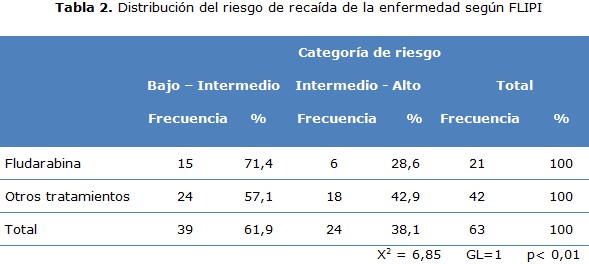Fludarabina en el tratamiento del linfoma no Hodgkin folicular
Resumen
Fundamento: el linfoma no Hodgkin folicular ocupa el segundo lugar entre los linfomas no Hodgkin de estirpe B, se caracterizan por un patrón de remisiones y recaídas continuas. La fludarabina constituye una opción de tratamiento del mismo al lograr una rápida remisión, con disminución del porciento de recaída.
Objetivo: evaluar la fludarabina como tratamiento de rescate del linfoma no Hodgkin folicular.
Métodos: se realizó un estudio observacional analítico de cohortes, longitudinal prospectivo concurrente. El universo de estudio lo conformaron los pacientes que acudieron a la consulta de Hematología con diagnóstico de linfoma no Hodgkin folicular y quedó constituido por 63 pacientes, de los cuales 21 seleccionados mediante muestreo no probabilístico intencionado que recibieron tratamiento con fludarabina, conformaron cohorte de expuestos, que se compararon con 42 pacientes con similares características que recibieron otros esquemas de poliquimioterapia que no incluyó la fludarabina y que constituyó la cohorte de no expuestos.
Resultados: fue mayor el número de pacientes con más de 50 años y del sexo masculino, perteneciente al estadio IV de Cotswold y los que tuvieron un riesgo de recaída de bajo - intermedio. El tiempo de sobrevida libre de enfermedad fue mayor en los tratados con fludarabina quienes presentaron menos complicaciones.
Conclusiones: en los pacientes tratados con la fludarabina como tratamiento de rescate del linfoma folicular el tiempo de sobrevida libre de la enfermedad fue mayor y se presentaron menos complicaciones, lo que demuestra su utilidad como tratamiento de primeria línea en ausencia del rituximab.
DeCS: LINFOMA NO HODGKIN/tratamiento farmacológico; LINFOMA NO HODGKIN/terapia; LINFOMA FOLICULAR/diagnóstico; RECURRENCIA; ESTUDIO OBSERVACIONAL.
Descargas
Citas
1. Moreno Laguarda Y, Laguna Salvia L, Larquin Comet JI, León Ramentol CC, Hernandez Soler YF, González Basulto MJ. Criterios diagnósticos y nuevas opciones terapéuticas para los pacientes con diagnóstico de Linfoma no Hodgkin. Arch méd Camagüey [Internet]. 2019 [citado 02 Nov 2020];23(3):415-426. Disponible en: http://scielo.sld.cu/scielo.php?script=sci_arttext&pid=S1025-02552019000300415&lng=es
2. Freedman AS, Jacobson CA, Mauch P, Aster JC. Non-Hodgkin’s lymphoma. En: De Vita VT, Lawrence TS, Rosenberg SA, editors. Cancer: Principles and Practice of Oncology. 10 th ed. Philadelphia: Lippincott Williams&Wilkins; 2015. p. 1552-1583.
3. Skrabek P, Turner D, Seftel M. Epidemiology of nonhodgkin lymphoma. Transfus Apher Sci 2013; 49:133-138.
4. Ministerio de Salud Pública. Dirección de Registros Médicos y Estadísticos de Salud. Anuario estadístico de salud 2018 [Internet]. La Habana: MINSAP; 2019 [citado 02 Nov 2020]:[aprox. 193 p.]. Disponible en: https://files.sld.cu/bvscuba/files/2019/04/Anuario-Electr%C3%B3nico-Espa%C3%B1ol-2018-ed-2019-compressed.pdf
5. Costa LJ, Maddocks K, Epperla N, Reddy NM, Karmali R, Umyarova E, et al. Diffuse large B-cell lymphoma with primary treatment failure: Ultra-high risk features and benchmarking for experimental therapies. American journal of hematology. 2017;92:161-70.
6. Wagner-Johnston ND, Link BK, Byrtek M. Outcomes of transformed follicular lymphoma in the modern era: a report from the National Lympho Care Study (NLCS). Blood. 2015;126(7):851-7.
7. Alonso Mariño OL, Alonso Mariño AL, Miranda Chaviano J. Caracterización clínico-epidemiológica de los linfomas en un período de cinco años en Villa Clara. Medicent Electrón [Internet]. 2015 [citado 01 Abr 2019];19(1):[aprox. 6 p.]. Disponible en: http://www.medigraphic.com/pdfs/medicentro/cmc-2015/cmc151c.pdf
8. Grover N, Park S. Novel targeted agents in Hodgkin and non-Hodgkin lymphoma therapy. Pharmaceuticals (Basel, Switzerland). 2015;8(3):607-636.
9. Sorge CE, McDaniel JK, Xavier AC. Targeted Therapies for the Treatment of Non-Hodgkin Lymphomas: Present and Future. Pharmaceuticals. 2016;9(28):6-12.
10. Novoa JE, Beñaran B, Rojo AL, Cuña A, Iriondo N, Calvo H, et al. Monofosfato de fludarabina como primera línea en el tratamiento de los síndromes linfoproliferativos crónicos. Estudio multicéntrico, Uruguay 1997-2012. Rev Hematol. 2013;14(1):21-25.
11. Instituto Nacional de Cancerología. ESE-Guía de Práctica Clínica para la detección, tratamiento y seguimiento de linfoma Hodgkin y no Hodgkin en población mayor de 18 años [Internet]. Colombia: Ministerio de Salud y Protección Social; 2017 [citado 02 Nov 2020]. Disponible en: http://gpc.minsalud.gov.co/gpc_sites/Repositorio/Conv_563/GPC_Linfoma_Mayores_18A%C3%B1os/GPC_Linfoma.pdf
12. Gómez Gómez M, Danglot Banck C, Vega Franco L. Cómo seleccionar una prueba estadística. Rev Mex Pediatr. 2013; 80(2):81-85.
13. Campo E, Swerdlow SH, Harris NL. The 2008 WHO classification of lymphoid neoplasms and be-yond: evolving concepts and practical applications. Blood. 2011;117:5019-32.
14. Ning Jiang J, Hua Sun X. The prognosis factors research on the 172 non-hodgkin lymphoma cases. Biomedical Research. 2016;27(2):336-344.
15. Sacchi S, Pozzi S, Marcheselli R, Federico M, Tucci A, Merli F, et al. Rituximab in Combination With Fludarabine and Cyclophosphamide in the Treatment of Patients With Recurrent Follicular Lymphoma. Cancer 2007; 110:121–8.
16. Wang Y, Wu J, He W. The Jejunum Non-Hodgkin’s Diffuse Large B cell Lymphoma: an Origin of Extra-Germinal Center. Int J Cancer Cell Biol Res. 2017;1(1):001-005.
17. Sicras Mainar A, Castro A, Navarro Artieda R. Características clínicas y respuesta al tratamiento de pacientes adultos con leucemia linfática crónica (LLC) y linfoma no Hodgkin (LNH). Gac Med Mex. 2016;152:59-69.
18. Alonso Álvarez S. Caracterización clínica y biológica del proceso de transformación de los síndromes linfoproliferativos indolentes. Análisis histológico, fenotípico y molecular [Tesis]. Salamanca: Universidad de Salamanca; 2016 [citado 31 Oct 2019]. Disponible en:
https://gredos.usal.es/jspui/bitstream/10366/132943/1/DM_AlonsoAlvarezS_Caracterizacion.pdf
19. American Cancer Society. Non-Hodgkin Lymphoma Treatment. ACS. 2015;60(3):664-71.
20. Tse E, Kwong YL. Recent Advances in the Treatment of Lymphomas. J Hong Kong Col Radiol. 2010;13(Suppl):S22-4.
21. Foussard C, Colombat P, Deconinck E. Original article long-term follow-up of a randomized trial of fludarabine-mitoxantrone, compared with cyclophosphamide, doxorubicin, vindesine, prednisone (CHVP), as fi rst-line treatment of elderly patients with advanced, low-grade non-Hodgkin’s lymphoma before the era of monoclonal antibodies; on behalf of the Groupe Ouest-Est des Leucemies et Autres Maladies du Sang (GOELAMS). Ann Oncol. 2005; 16:466-72.
22. Zinzani PL, Pulsoni A, Perrotti A. Fludarabine plus mitoxantrone with and without rituximab versus CHOP with and without rituximab as front-line treatment for patients with follicular lymphoma. J Clin Oncol. 2004; 22:2654-61.
23. Labardini Méndez JR, Cervera Ceballos E, Corrales Alfaro C, Balbuena Martínez M, Barbosa Ibarra AA, Espinoza Zamora JR, et al. Oncoguía: Linfoma No Hodgkin. Cancerología 6. 2011:139-152.
24. Arcaini L, Merli M, Passamonti F. Validation of follicular lymphoma international prognostic index 2 (FLIPI2) score in an independent series of follicular lymphoma patients. Br J Haematol. 2010; 149(3):455-7.
25. Luminari S, Bellei M, Biasoli I, Federico M. Follicular lymphoma: treatment and prognostic factors. Rev Bras Hematol Hemoter [Internet]. 2012 [citado 31 Oct 2019];34(1):[aprox. 5 p.]. Disponible en: http://www.scielo.br/scielo.php?script=sci_arttext&pid=S1516-84842012000100015&lng=en
26. Redman JR, Cabanillas F, Velasques WS. Phase II trial of fludarabine phosphate in lymphoma: an effective agent in low grade lymphoma. JCO. 2012;10:790-794.
27. Cencini E, Fabbri A, Schiattone L, Bartalucci G, Bocchia M. Radiotherapy with rituximab as first-line treatment for early-stage follicular lymphoma. Leuk Lymphoma. 2015;56(10):2997-8.
28. Physician Data Query. Tratamiento del linfoma no Hodgkin en adultos [Internet]. Bethesda, MD: National Cancer Institute; 2016 [citado 6 Oct 2019]. Disponible en:
https://www.cancer.gov/espanol/tipos/linfoma/pro/tratamiento-lnh-adultos-pdq

Publicado
Cómo citar
Número
Sección
Licencia
La Revista Archivo Medico Camagüey, ofrece de forma inmediata después de ser indexada en el Proyecto SciELO; acceso abierto al texto completo de los artículos bajo el principio de hacer disponible y gratuita la investigación para favorecer el intercambio del conocimiento global y coadyuvar a una mayor extensión, publicación, evaluación y uso extensivo de los artículos que se exponen pudiendo ser utilizados, sin fines comerciales, siempre y cuando se haga referencia a la fuente primaria.
Carta De Declaración De Autoría u Derechos De Autor(a)
Conflictos de intereses: los autores deberán declarar de forma obligatoria la presencia o no de conflictos de intereses en relación con la investigación presentada. (Descargar Plantilla para declarar confictos de intereses)
La Revista Archivo Médico Camagüey se encuentra bajo una
Licencia Creative Commons Reconocimiento-NoComercial 4.0 International (CC BY NC 4.0).
Esta licencia permite a otros distribuir, mezclar, ajustar y construir a partir de su obra, incluso con fines comerciales, siempre que le sea reconocida la autoría de la creación original. Esta es la licencia más servicial de las ofrecidas. Recomendada para una máxima difusión y utilización de los materiales sujetos a la licencia. La licencia completa puede consultarse en: https://creativecommons.org/licenses/












